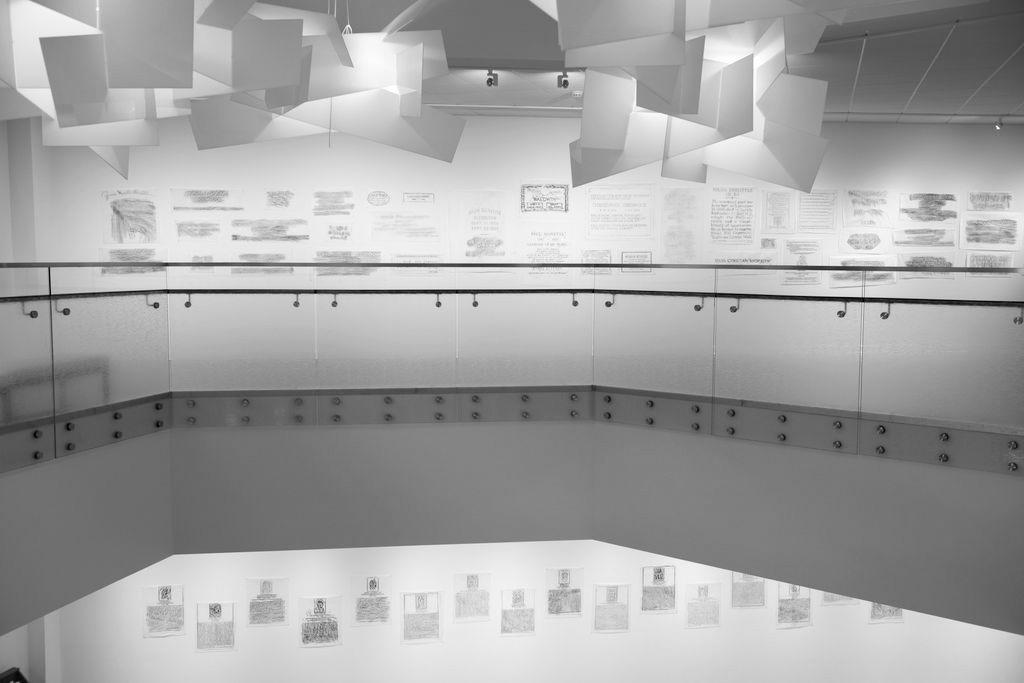Steven Reigns, a Los Angeles-based poet and educator, held workshops and talks on campus Wednesday through Friday last week in connection with his curated exhibition “The Gay Rub,” currently on display in the Smith Gallery.
The collection consists of over 100 rubbings of crayon on fabric taken from public monuments, signs and tombstones paying homage to prominent moments of queer history all over the world.
The concept might have been hard for people to wrap their heads around it at first, Reigns said, but it now has mass appeal and rising engagement, especially on college campuses.
“As an educator I feel like we have the responsibility to show the rights of all people,” said Jody Servon, director of Smith Gallery and associate professor in the art department at Appalachian State University.

“This is a way to show who has come before us and how artists are interpreting that information and making it new. It inspires to think about what’s around us every day – do we see the prejudice and discrimination? Do we see the markers of our past?”
The Appalachian spoke with Reigns about this collection and his own work.
The Appalachian: Can you give me a little bit of background information about this project?
Steven Reigns: “I came up with the idea five years ago this month – I know that because I keep a journal. I discovered that a plaque about a mile away from my house in West Hollywood was dedicated to transgendered victims of hate crimes. I found out that it was the first in the world, and I thought ‘I wonder how many other plaques are out there in the world, and what do they look like, who do they honor?’ Then, right away I came up with the idea that I should collect rubbings of those. It was interesting because the last time I had done a rubbing was in 1986 in summer camp, where most people do rubbings, and the time before that was in kindergarten, where we would take a leaf from the playground and trace it. It seemed like it was a perfect way to show the plaques and the markers as opposed to photographs, which might rub the tactile nature. It also takes someone interacting with it, and it’s amazing to spend the time it takes just to do the rubbing – its almost like meditation.
I have two friends who were in Germany doing a rubbing of a big triangle plaque that translates to ‘against forgetting.’ When they were doing it, an older woman stopped them and was very concerned. She didn’t really speak any English but she wanted to communicate with them that this marker dedicated to the gays and lesbians lost in the holocaust, that they weren’t damaging it at all. It took them a while with their limited German to show her what they were doing, but when she realized she was so happy that these Americans wanted to take some of this back. Little does she know that the rubbing is now traveling around, and people get to see it. It’s a way of bringing queer history to people. It’s a way of exposing people to forgotten artists and reminding people of the gayness that is present in our history.”
TA: How much of this is artistic, and how much is historical, for you personally?
SR: “I think that it embodies both, and I think that’s why it is so well-suited to universities. There’s the interactive component, and there’s something about people going out and engaging with public commemorative markers and that’s rarely done. We’re learning about history. There have been so many great strides with marriage equality and those seem shaky. It’s really easy to forget how it was even 1969, the birth of the gay civil rights movement, how recent that is. That was only six years after my birth. It’s such recent history and I don’t think the LGBT experience gets adequate recognition or air time or respect.”
TA: What’s your goal in bringing this to universities?
SR: “With universities you have people committed to intellectual dialogue and artistic expression and exploration, so it seems a really good fit in that regard. People are here with an enthusiasm for academics and learning and growth and it seems well placed.”
TA: Can you tell me a little more about the workshops you’ve been teaching while you’re here?
SR: “I’ve been teaching autobiographical writing workshops, and so far it has been only with the art classes, which has been great. Artists are going to use text in their visual work at times, and they’re always going to have to write artists’ statements or writing about their own work. There’s a power that goes with autobiographical writing. We’re not in a culture that encourages creativity or self-disclosure, so it’s a bold, transgressive act to do that. The writer is unfortunately positioning themselves to have their craft criticized as well as their personal life criticized, and I think that’s why we don’t see it as often as I would like.”
TA: What do you hope people take away from your time here, and what do you hope to take away?
SR: “I want people to come to the exhibition and look around with an open mind and read the accompanying booklet and just to take whatever they want from it. In a way, it’s a very quiet exhibition. It’s very stark and I think the rubbings are very haunting – the white fabric with the black markers – it’s not very loud and it’s not screaming or demanding attention. That’s one experience that I might want someone to have, but another one is for it to spark discussion and conversation.”
“The Gay Rub” will be on display from Jan. 20 to Feb. 13 in the Smith Gallery in Plemmons Student Union.
Story: Lovey Cooper, Senior A&E Reporter
